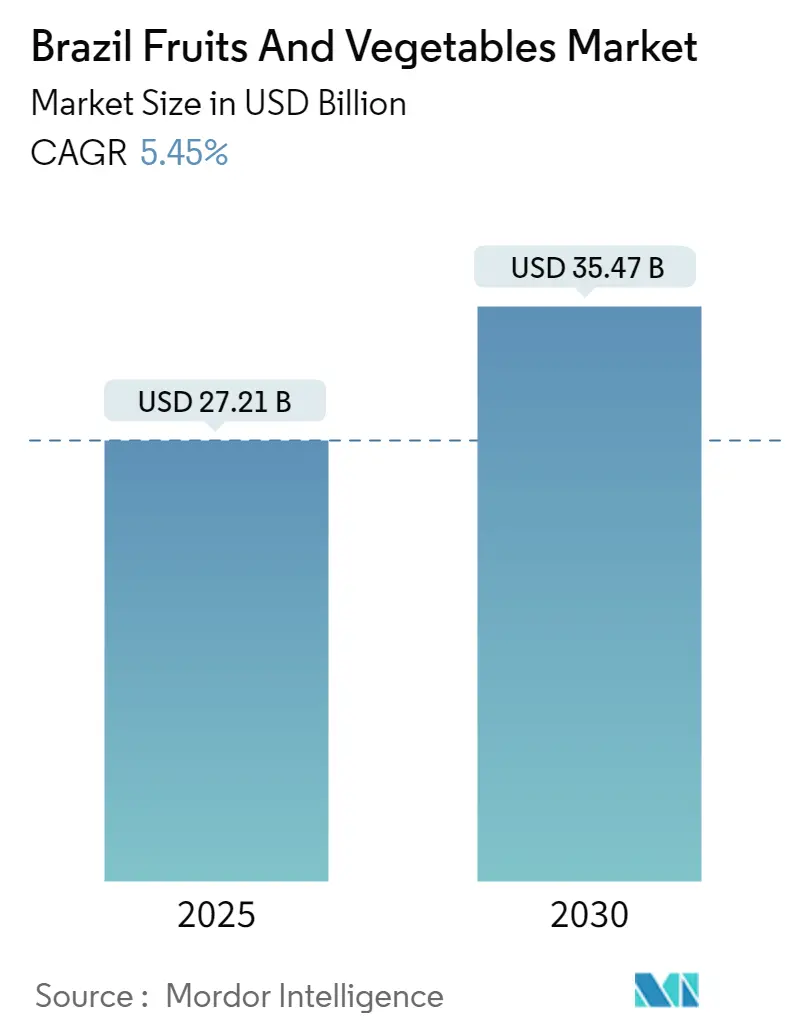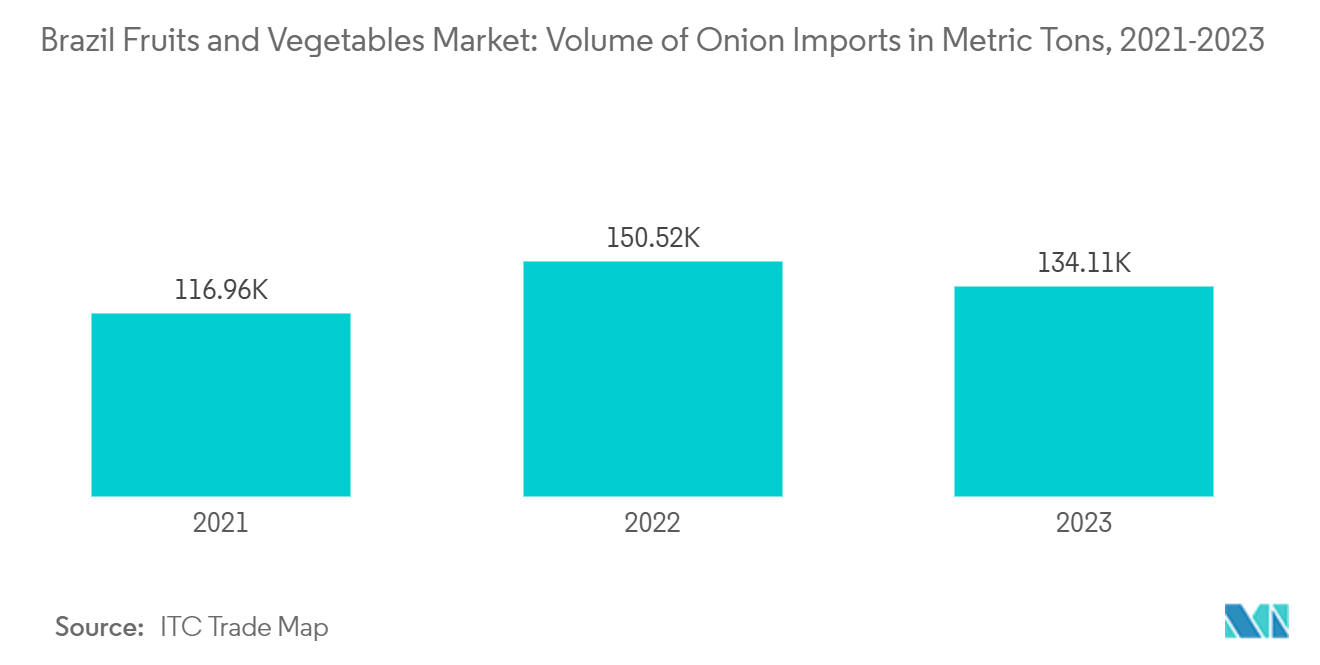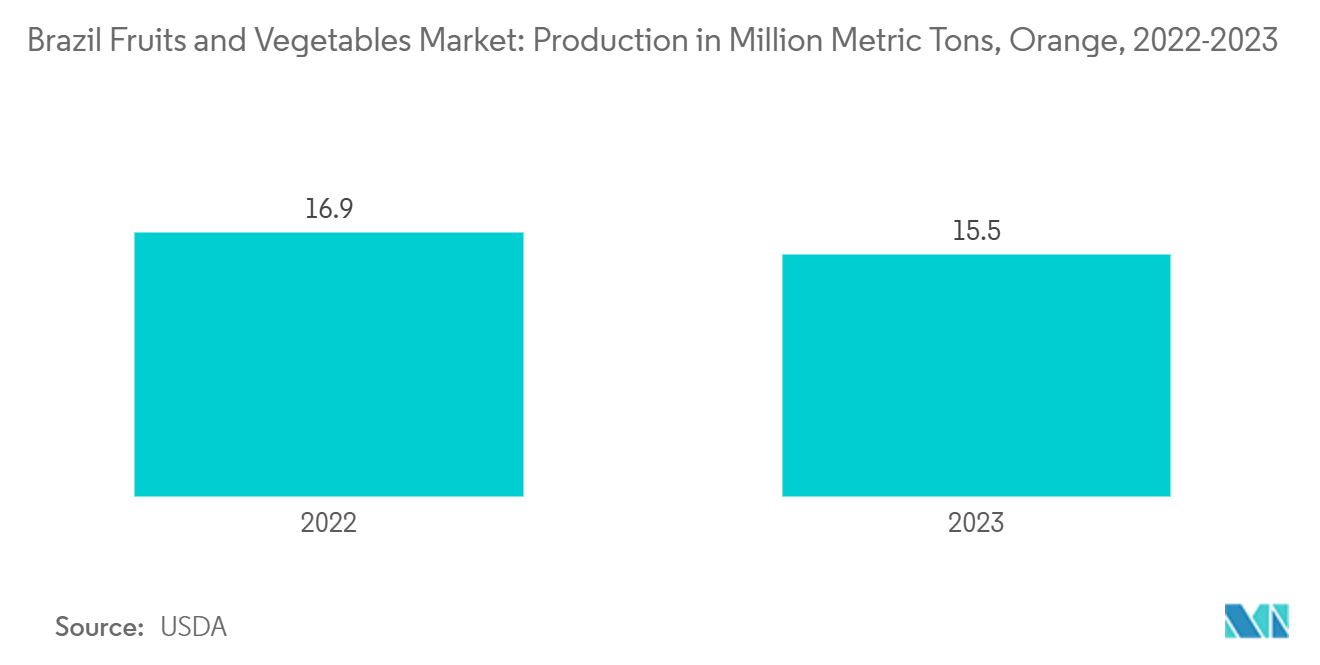Brazil Fruits And Vegetables Market Analysis
The Brazil Fruits And Vegetables Market size is estimated at USD 27.21 billion in 2025, and is expected to reach USD 35.47 billion by 2030, at a CAGR of 5.45% during the forecast period (2025-2030).
Brazil's fruits and vegetables market is a dynamic sector in the country's agribusiness, leveraging its vast geographical area, favorable climate, and rich biodiversity. This sector significantly contributes to both domestic consumption and international trade, with a wide range of tropical and temperate produce grown across various regions.
Brazil ranks among the world's top producers of fruits, including oranges, bananas, pineapples, and papayas. According to the Food and Agriculture Organization, in 2022, Brazil produced 16.9 million metric tons of oranges, 6.9 million metric tons of bananas, 2.3 million metric tons of pineapples, and 1.1 million metric tons of papayas. As the world's largest orange producer, Brazil dedicates a significant portion of its output to juice production. The United States Department of Agriculture reports that as of 2023, Brazil accounts for 72% of global orange juice production. While banana and pineapple production is substantial, it primarily serves domestic consumption. The vegetable sector in Brazil is diverse, with key crops including tomatoes, potatoes, onions, and carrots. Unlike the fruit sector, which often involves larger commercial farms, vegetable production is more fragmented and characterized by a higher proportion of smallholder farmers.
Brazil's domestic fruits and vegetables market is experiencing growth, driven by the expanding middle class and increasing urbanization. Health-conscious Brazilian consumers are fueling demand for fresh produce, including exotic and minimally processed options. Supermarkets and urban food retailers are becoming key distribution channels for fresh produce, while traditional street markets remain important in smaller towns and rural areas. Fruit exports are a vital component of Brazil's agricultural economy, with the European Union serving as a primary destination, particularly for mangoes, melons, and table grapes. The country is also exploring new markets in Asia and the Middle East to diversify its export base to China, South Korea, Japan and Taiwan. The Brazilian fruits and vegetables market is anticipated to grow due to its diverse production, rising domestic demand, and strong export potential.
Brazil Fruits And Vegetables Market Trends
Domestic Demand for Vegetables in Brazil
- Brazil boasts a diverse agricultural sector, producing a wide variety of vegetables. The country's major vegetable crops include tomatoes, potatoes, onions, carrots, lettuce, and garlic. Key production regions are São Paulo, Minas Gerais, and Paraná. Brazil's favorable climate enables year-round vegetable cultivation, meeting domestic demand and creating export opportunities. The vegetable market in Brazil is characterized by a mix of large-scale producers and small family-owned farms. Distribution primarily occurs through supermarkets and open-air markets. While the growth of supermarkets has influenced vegetable distribution, traditional markets remain important, particularly in rural areas and smaller towns.
- Despite being largely self-sufficient in vegetable production, Brazil imports certain products to supplement domestic supply, especially during off-seasons or production shortfalls. Garlic is a significant import, primarily sourced from China and Argentina, due to insufficient domestic production. In 2023, garlic imports constituted 30.9% of total vegetable import value, according to ITC Trade Map data. Recent years have also seen a notable increase in onion imports, mainly from Argentina and the Netherlands. Onion imports rose by 14.7%, from 116,963 metric tons in 2021 to 134,109 metric tons in 2023. The growing demand for vegetables in Brazil is driven by increasing health awareness and evolving dietary preferences, reflecting a broader shift towards healthier lifestyles.
Brazil is the Largest Producer of Orange in the World
- The orange industry is vital to Brazil's agricultural sector, significantly affecting the economy and international trade. According to the USDA, in 2023, Brazil was among the top global orange producers, with a production of 15.5 million metric tons. However, this represented an 8.6% decrease from the previous year's 16.9 million metric tons. The decline was due to several factors, including an accelerated harvesting pace to reduce fruit drop and production losses, although the fruit drop rate remained above historical averages. A major contributing factor to the decreased production was a shift in weather patterns during the growing season. The first half of 2023 experienced abundant rainfall, followed by a lack of precipitation in the next six months, which continued until the end of the season in 2024. The altered weather conditions, along with the aggravation of citrus greening disease and hastened harvest pace, reduced the growth period for oranges. For instance, the country is set to have its worst harvest in 36 years after a heat wave severely hurt crops, according to research group Fundecitrus.
- The primary orange varieties produced in Brazil include Hamlin, Westin, Rubi, Valencia Americana, Seleta, Pineapple, BRS Alvorada, Pera Rio (pear orange), Valencia, "Folha Murcha" Valencia, and Natal. Brazil's orange value chain is highly industrialized. In recent years, Brazilian producers have seen an increased rate of orange production, which has prevented a significant decline despite reduced acreage. According to the United States Department of Agriculture, approximately 30% of Brazil's orange output is allocated for the fresh market, while 70% is processed into juice each year. With a total of 5,134 orange grove properties, predominantly large-scale producers with high yields, Brazil's orange industry continues to be pivotal to the national economy and the international orange juice market, demonstrating the sector's resilience and adaptability to market demands and environmental challenges.
Brazil Fruits and Vegetables Market News
- September 2024: In a collaborative effort, Brazil's Ministry of Agriculture and Livestock, alongside the Ministry of Foreign Affairs, has successfully opened 200 new international markets for its agribusiness, including fruits and vegetable products, over the past 20 months.
- April 2024: Cutrale, a major global orange juice supplier, announced an investment of USD 100.55 million in Brazil's Mato Grosso do Sul state. The investment plan includes planting oranges on 5,000 hectares in the town of Sidrolandia, followed by establishing a processing facility. This strategy aims to expand operations into regions with lower incidence of citrus greening disease.
- April 2024: Brazil's Ministry of Agriculture, Livestock and Supply (known as MAPA in Portuguese) has enacted Ordinance No. 669/2024. This ordinance raises the minimum purchasing price for oranges in Rio Grande do Sul for the 2024/2025 agricultural season. Specifically, the price per 40.8 kg box has been elevated from USD 4.05 to USD 4.25. This new pricing takes effect on July 1, 2024, and remains in force until June 30, 2025.
Brazil Fruits And Vegetables Industry Segmentation
The Brazilian fruits and vegetables market is segmented by type (fruits and vegetables). The report includes production (volume), consumption (volume and value), import (volume and value), export (volume and value), and price trend analysis. Price analysis covering the top 10 fruits and vegetables across Brazil has also been included. The report offers market size and forecast in terms of value in USD million and volume in metric tons for the above-mentioned segments.
Brazil Fruits and Vegetables Market Research FAQs
How big is the Brazil Fruits And Vegetables Market?
The Brazil Fruits And Vegetables Market size is expected to reach USD 27.21 billion in 2025 and grow at a CAGR of 5.45% to reach USD 35.47 billion by 2030.
What is the current Brazil Fruits And Vegetables Market size?
In 2025, the Brazil Fruits And Vegetables Market size is expected to reach USD 27.21 billion.
What years does this Brazil Fruits And Vegetables Market cover, and what was the market size in 2024?
In 2024, the Brazil Fruits And Vegetables Market size was estimated at USD 25.73 billion. The report covers the Brazil Fruits And Vegetables Market historical market size for years: 2019, 2020, 2021, 2022, 2023 and 2024. The report also forecasts the Brazil Fruits And Vegetables Market size for years: 2025, 2026, 2027, 2028, 2029 and 2030.
Our Best Selling Reports
Brazil Fruits and Vegetables Industry Report
Statistics for the 2025 Brazil Fruits And Vegetables market share, size and revenue growth rate, created by Mordor Intelligence™ Industry Reports. Brazil Fruits And Vegetables analysis includes a market forecast outlook for 2025 to 2030 and historical overview. Get a sample of this industry analysis as a free report PDF download.





